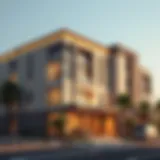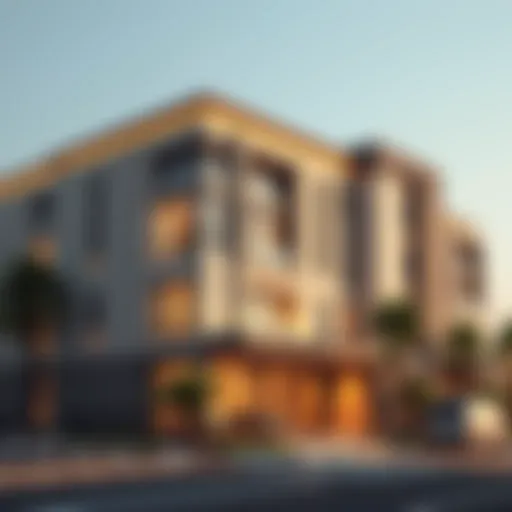Exploring Dubai's Metro Lines: Impact on Urban Mobility
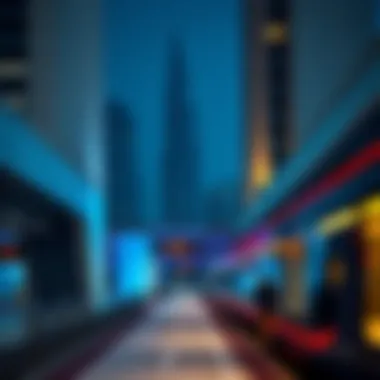

Market Analysis
Dubai’s rapid evolution as a global hub for business and tourism has ushered in a unique set of challenges and opportunities for its property market. As the city turns towards sustainable development, public transit systems, particularly the metro lines, have become pivotal in shaping urban landscapes. The integration of metro lines with real estate development is not merely a trend; it's a strategic element influencing property values and investor interest across neighborhoods.
Current Trends in Property Prices
Diving into the current property prices, it's clear they're closely linked to the accessibility offered by metro stations. Homes located near metro stations have seen a surge in demand. For instance, properties in areas like Dubai Marina or Jumeirah Lakes Towers, which benefit from nearby metro access, often command higher prices than those further away. As of late 2023, average prices in these hotspots have ranged between AED 1.5 million to AED 3 million, reflecting this proximity advantage.
Moreover, emerging neighborhoods like Dubai South are witnessing a slower but steady appreciation due to anticipated metro connectivity in the coming years. Buyers are keenly aware of these patterns, understanding the intrinsic value public transport adds to their potential investments.
Future Growth Projections
Looking ahead, the prospects for Dubai's metro network appear promising, with plans to expand the existing lines and introduce new stations. Property analysts predict that this expansion will bolster property prices further in serviced zones.
The expected completion of the Expo 2020 district's metro link is a prime example. With this connectivity, properties in areas such as Expo and Dubai World Central are anticipated to experience noteworthy price hikes, making them attractive for both investors and homeowners alike.
In summary, the interplay between Metro lines and property investment is clear: greater connectivity correlates with higher property values. Investors willing to align their investments with metro expansion plans stand to benefit significantly from the rising tides of Dubai’s real estate market.
Buying and Selling Tips
Acquainting yourself with the mechanics of buying and selling properties around metro lines can significantly tip the scales in favor of informed decision-making.
Essential Steps for First-Time Buyers
- Research Locations: Prioritize areas with existing or forthcoming metro lines to gain long-term value.
- Check Accessibility: Evaluate walking distances to metro stations, ensuring convenient travel for daily commuting.
- Understand Market Trends: Keep an eye on local property trends; past increases can indicate future values.
These steps can help first-time buyers navigate the market with confidence.
Strategies for Selling Properties Effectively
- Highlight Proximity to Metro: Make sure to emphasize the distance to the nearest metro station in listings.
- Professional Assessments: Consider hiring a property valuer for a market-driven valuation. This helps set a fair price.
- Tailored Marketing: Promote listings focusing on the benefits of urban mobility and lifestyle conveniences.
With the right strategies, sellers can effectively tap into the growing demand for metro-adjacent properties.
"Public transit is not just about mobility; it’s a catalyst for community growth and economic development." - Urban Mobility Insights
Overview of the Metro System in Dubai
The Dubai Metro stands out as a flagship achievement in urban transportation, redefining how residents and visitors alike navigate this vibrant city. With over 75 kilometers of track and 47 stations, the metro not only improves mobility but also enhances the overall urban experience.
"The Dubai Metro is not just a transit system; it’s a life line connecting aspirations, communities, and opportunities."
Historical Context
Construction of the Dubai Metro began in 2006, as a part of the emirate's larger vision for urban planning. The project aims to alleviate traffic congestion, reduce carbon emissions, and promote sustainable transportation. The initial phase, which opened in September 2009, included the Red Line stretching from Rashidiya to Dubai Marina. The rapid development of Dubai necessitated this ambitious project, as the population was expected to grow exponentially. Thus, in little time, it became the longest fully automated metro system in the world.
This modern mode of transportation can be linked to Dubai’s remarkable transformation—from a relatively quiet trading port to a bustling global city. The metro embodies the UAE's drive towards innovation and efficiency, serving as a potential model for other rapidly developing urban areas.
Significance of the Metro in Urban Development
The metro is a linchpin in Dubai's strategic urban development plan. Its implementation has led to several urban benefits, which are significant for real estate agents and investors:
- Increased Accessibility: By providing reliable transportation, the metro opens up previously inaccessible areas. This has sparked interest in neighborhoods near metro stations, driving up property values.
- Enhanced Property Development: Many developers have acted upon areas around metro stations, building residential and commercial complexes, which directly enhance the quality of life and convenience for residents.
- Support for Tourism: With the metro, visitors can explore attractions like the Burj Khalifa and Dubai Mall with ease. This connectivity boosts tourism-related investments.
- Sustainable Urban Growth: The emphasis on public transit reduces vehicular traffic, encouraging eco-friendly living. This approach aligns with global trends advocating for sustainable city planning.
Investors and property buyers can gauge their decisions by considering metro access as a significant factor in property value. As such, understanding the nuances of the Dubai Metro is critical for anyone looking to make informed choices in the real estate market.
Finale
In summary, the Dubai Metro is an intricate assembly of infrastructure, historical foresight, and strategic planning, making it a vital aspect of urban life. Its establishment not only addresses immediate transportation needs but also forecasts urban growth, positioning itself as a catalyst for real estate development and economic prosperity.
Key Metro Lines Overview
The metro system in Dubai stands as a paradigm of modern urban transit solutions, bridging diverse neighborhoods while driving significant economic and developmental changes in the city. Understanding the key metro lines, particularly the Red and Green lines, is essential for real estate agents, investors, and potential homebuyers. Knowledge of these routes provides insights into property values, accessibility, and the overall landscape of community connectivity.
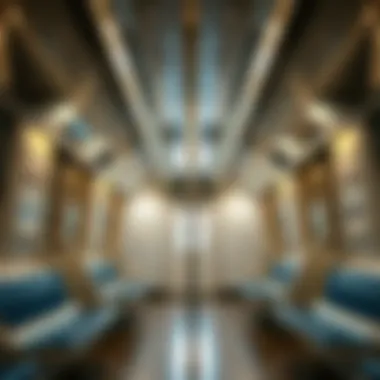

The metro lines facilitate movement across the city, linking key commercial areas with residential neighborhoods. It is not just about transit; it is about how these lines reshape perceptions of accessibility and influence urban planning. Buyers now factor in metro proximity when determining property worth, making the understanding of these lines crucial for anyone involved in Dubai's real estate market.
Red Line: Major Highlights
The Red Line, inaugurated in 2010, runs from Rashidiya to UAE Exchange, covering approximately 52 kilometers. It is significant due to its robust link to crucial districts, such as Downtown Dubai, which is home to the Burj Khalifa, and the Dubai Marina, a favorite among expatriates and tourists alike. The line enhances the appeal of nearby neighborhoods like Al Karama and Al Qusais, thereby influencing local property prices.
Highlighting some major stations along the Red Line:
- Burj Khalifa/Dubai Mall: Direct access to one of the world's busiest shopping destinations.
- Financial Centre: Serves the bustling business district.
- Mall of the Emirates: A key destination for shopping and leisure.
By providing an efficient route to these hotspots, the Red Line does not just facilitate daily commutes, but also fosters investment opportunities. Developers are encouraged to build mixed-use projects near these stations, as the convenience significantly boosts foot traffic and potential sales.
Green Line: Connecting Communities
In contrast, the Green Line’s 22.5 kilometers span from the Dubai Creek area to Al Jouf, providing essential connectivity for older districts while integrating communities that may have been previously overlooked. This line plays a critical role in community development, as it touches various culturally rich areas such as Deira and Al Ras. These neighborhoods have a unique charm and often feature lower property prices compared to more affluent districts, making them exciting prospects for investment and development.
Key features of the Green Line include:
- Al Gubaiba: A hub for connecting with buses and taxis, facilitating easy transfers.
- Union: This station allows seamless transfer to the Red Line, enhancing mobility for users.
The integration of the Green Line in Dubai's transportation fabric ensures that growth is balanced. It encourages rehabilitation of older areas, bridging gaps between different parts of the city and enhancing overall urban cohesion.
Future Extensions: Plans and Projections
Looking ahead, the Dubai metro system is set to expand further, with several future extensions envisioned to enhance accessibility. Plans include stretching the Red Line towards the Expo 2020 site, now rebranded as District 2020, and extending the Green Line further north to reach residential zones that are currently underserved.
Projected benefits of these expansions involve:
- Improved access to new residential communities made up of emerging developments.
- Boosting property values in newly connected areas, transforming the real estate landscape.
- Alleviating traffic congestion on major roadways as more residents turn to metro for commuting.
Moreover, these enhancements underscore the commitment of Dubai's government to invest in sustainable urban infrastructures, which not only meets the immediate transit needs but also paves the way for long-term economic growth and real estate potential.
"The metro is more than just a means of transport; it's a blueprint of how Dubai is evolving as a global city, impacting lifestyles and real estate decisions."
Impact on Dubai's Real Estate Landscape
The metro system in Dubai is more than just a means of transportation. It plays a pivotal role in shaping the real estate landscape of the city. With lines weaving through bustling districts and emerging communities, the influence of the metro on property values and urban development deserves a closer look. As people flock to Dubai for work, leisure, and investment opportunities, understanding the connectivity offered by the metro can provide crucial insights for real estate agents, investors, and homebuyers alike.
Property Values and Metro Accessibility
When it comes to property market dynamics, accessibility often takes center stage. Properties located near metro stations generally see a boost in demand. Today’s buyers are not just looking for four walls—they want connectivity and convenience. Accessibility to metro stations translates to time savings and ease of travel, making properties within close proximity more desirable.
In neighborhoods like Dubai Marina, where the metro stations are just stone's throw away, property values have surged significantly. A direct connection to key commercial districts and leisure spots is a game-changer. For example, a property that sits just a five-minute walk from a metro station could command higher rents, appealing to expatriates and tourists alike who prioritize easy commutes.
However, it's not just about location; the overall neighborhood's development plays a critical role too. Here’s how metro accessibility affects property values:
- Increased Demand: As more people value the ease of living close to transit, you’ll see heightened interest in properties nearby.
- Price Appreciation: Over time, properties in these prime locations tend to appreciate faster than ones further away from transport links.
- Amenities Growth: Developers are keen to invest in areas surrounding metro lines, leading to improved local amenities, which in turn boosts property values.
The metro system directly contributes to property valuation in Dubai, making it essential for stakeholders in the real estate market to stay abreast of metro expansion updates.
Gentrification and Urban Renewal
Gentrification has become a buzzword, often sparking vigorous debates, but what really is its relationship with the metro system in Dubai? As metro lines cut through older parts of the city, areas once overlooked begin to experience fresh investments. This can lead to revitalization, attracting a mix of new residents and businesses eager to capitalize on improved accessibility.
While some locals may face challenges as property prices rise, urban renewal can bring much-needed attention, infrastructure upgrades, and community services. These changes often breathe new life into older neighborhoods, enriching the area’s cultural and economic fabric. Let’s examine the facets of gentrification linked to the metro:
- Investment Opportunities: Investors are increasingly looking towards evolving neighborhoods fed by new metro lines.
- Increasing Property Values: As areas gentrify, property values can skyrocket, sometimes pushing out long-term residents who can no longer afford rent.
- Mixed-Use Developments: Developers have begun to construct mixed-use projects that blend residential with commercial ventures near metro stations. This approach creates vibrant areas that can cater to a myriad of needs.
Ultimately, the intricate relationship between the metro and gentrification reflects broader trends of urban development. For those involved in Dubai's real estate, it’s crucial to approach these changes with a balanced perspective, recognizing both the opportunities and challenges presented by the shifting landscape.
User Experience and Operational Efficiency
In a bustling metropolis like Dubai, the user experience within the metro system is paramount. It's not just about getting from point A to point B; it's about making the journey enjoyable, efficient, and safe for every passenger. Operational efficiency ties directly into enhancing user experience, as it ensures that services run smoothly and consistently, which ultimately fosters passenger trust.
Ticketing and Fare Structure
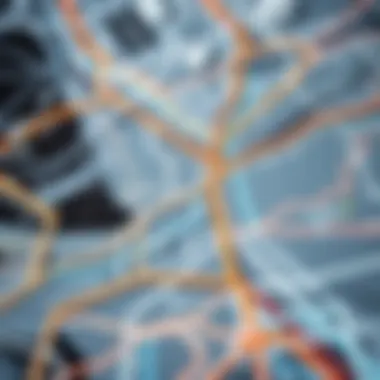
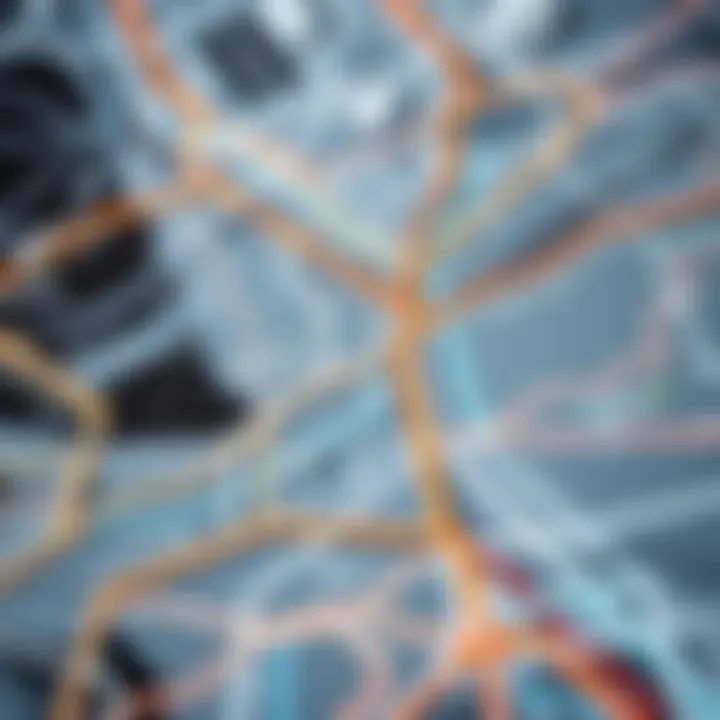
Navigating the ticketing system in Dubai's metro can be fairly straightforward when one understands the options available. Passengers usually have a variety of fare choices that cater to different commuting needs. Here are some key points regarding the ticketing system:
- Nol Cards: These are the most common, easy-to-use smart cards. There are several types like Nol Red Ticket for tourists and Nol Silver or Gold Cards for regular users. Each type has its own fare benefits, with the Gold Card allowing access to the premium cabins.
- Fare Structure: Fares are determined based on the distance traveled. The pricing is tiered; shorter distances can cost as little as AED 3, and longer journeys may peak around AED 7.5. This tiered approach is affordable and encourages more people to use the metro rather than drive.
- Payment Options: Online top-ups are available, making it easy for people to add credit to their Nol Cards without having to stand in line at a vending machine or customer service center. This convenience extends the transit experience, saving time for commuters.
"The ticketing system is designed with the user in mind, ensuring seamless access to Dubai’s expansive metro network."
With varied ticketing options, passengers are more likely to choose the metro over other forms of transport, thus reducing congestion on the roads and lowering overall travel stress.
Safety and Maintenance Standards
Safety must always come first, especially in urban transport systems where the volume of passengers can easily spiral. The Dubai Metro employs rigorous safety measures and maintenance protocols designed to keep its users secure during their commutes. Here’s an insight into these standards:
- Regular Inspections: Trains and tracks undergo thorough inspections not only to meet operational standards but also to preemptively identify any potential issues. This proactive approach minimizes downtime due to mechanical failures.
- Security Personnel: Trained personnel are stationed throughout the metro. Their roles are not just to maintain order but to provide immediate assistance when required. This on-ground support boosts passenger confidence in safety.
- Technological Integration: Advanced surveillance systems are employed within stations and trains. These systems not only monitor activity but also aid in the swift response to any incidents, ensuring passenger safety is always prioritized.
- Emergency Protocols: Emergency drills are conducted regularly for staff, ensuring they know how to handle various situations while keeping passengers informed and safe. Clear signage and announcements help in guiding passengers during any emergencies.
By adhering to high safety and maintenance standards, Dubai’s metro not only assures passengers of their safety but reinforces the idea that public transport can be a reliable cornerstone of urban living.
Efforts to streamline user experience and guarantee operational efficiency are crucial for anyone relating to the real estate sector in Dubai. The less hassle a potential commuter has with navigating transit, the more attracted they are to neighborhoods accessible via the metro. As new lines and stations continue to be developed, the influence of the metro on property values and lifestyles in Dubai remains significant.
Challenges Facing the Metro System
The metro system in Dubai, while a marvel of modern engineering and a boon for urban connectivity, is not without its challenges. Understanding these challenges is vital for stakeholders in the real estate and developmental sectors, as they hold implications for future investments and the overall efficiency of urban mobility.
Operational Costs and Funding
Operating a metro system comes with its hefty price tag. The expenses range from daily maintenance and staff salaries to energy consumption. In the face of booming demand, Dubai's metro network needs constant upgrades and expansions to ensure smooth operation. This leads to a spiral: as costs rise, funding must be sought from various sources.
To navigate these financial waters, the government often looks toward public-private partnerships. These partnerships can alleviate some of the financial burden but come with their own sets of complexities, not least in negotiations and profit-sharing models. Moreover, rising operational costs could lead to increased fares for users, causing potential pushback from the public.
In light of these complexities, investing in sustainable funding models and cost-efficient technologies has become paramount.
"Managing operational costs effectively is as crucial as constructing new lines. Without a judicious approach, the financial viability of the metro system could come under serious scrutiny."
Increasing Demand and Capacity Issues
With Dubai's population continuing to swell, the existing metro infrastructure faces pressing capacity challenges. More riders mean the trains fill up faster, leading to overcrowding during peak hours, which can be particularly frustrating for daily commuters.
To address these issues, several strategies are being looked at, such as increasing the frequency of trains and expanding the length of current services. Additionally, the introduction of new lines could also help to distribute passenger loads more evenly across the network.
Yet, these solutions are not trivial. Real estate developments that spring up in proximity to metro lines may further exacerbate the situation, adding more passengers than the system can comfortably accommodate without careful planning.
Integration with Other Forms of Transportation
The connectivity of Dubai's metro system to other forms of transportation is vital for ensuring a seamless travel experience across the city. It’s not just about hopping on a train; it’s about creating an effective urban mobility network that allows residents and visitors alike to move efficiently from point A to B. This integration significantly influences the broader urban landscape, enhancing accessibility and convenience for commuters.
Such integration promotes greater public transit usage – the more options available, the more likely people are to leave their cars at home. This not only helps to ease traffic congestion but also plays a pivotal role in reducing carbon emissions.
Buses and Metro Connectivity
Buses are perhaps one of the most crucial components when discussing public transport connectivity. In Dubai, a well-structured network of bus routes complements the metro lines, creating a comprehensive transit ecosystem.
- Direct Links: Several bus routes run parallel or intersect with metro lines, allowing passengers to transition smoothly without needing long detours.
- Comprehensive Coverage: Buses extend the reach of the metro, allowing access to neighborhoods not directly served by train stations.
- Integrated Timetables: Synchronization between bus schedules and metro arrivals ensures minimal wait times, making it convenient for commuters to make connections.
For example, a passenger might disembark at the Mall of the Emirates station and hop on a bus to reach the nearby residential complexes. This interoperability bolsters the metro’s role in enhancing daily commutes.
Taxis and Ride-Hailing Services
Taxis and ride-hailing services like Careem and Uber further enhance mobility around the metro system. While the metro is efficient, the last mile can often present challenges, and this is where taxis shine.
- Accessibility at Stations: Taxi stands are prominently placed at metro stations, ensuring instant access for those who prefer not to walk or wait for public buses.
- Flexibility of Options: Ride-hailing applications add another layer of convenience, allowing users to book a ride from anywhere to any destination with just a few taps on their smartphones.
- Enhancing Convenience: Whether it’s catching a ride after a late-night event or avoiding the heat while moving between destinations, these options cater to various needs, blending in well with the metro’s operational framework.
A fully integrated system like this not only improves traveler satisfaction but also increases the overall efficiency of urban mobility in Dubai. As public transport continues to evolve, understanding these connections presents crucial insights for those involved in real estate and urban planning.
"The beauty of Dubai’s transportation network lies in its fluidity and seamless integration, making life easier for residents and visitors alike."
Given the scale of the metro and the extensive bus and taxi services, it’s clear that Dubai is not just building a transit system; it’s crafting an intricate tapestry of transportation solutions.
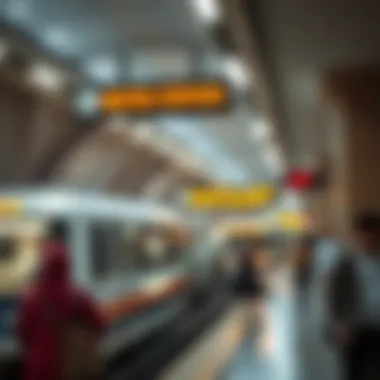
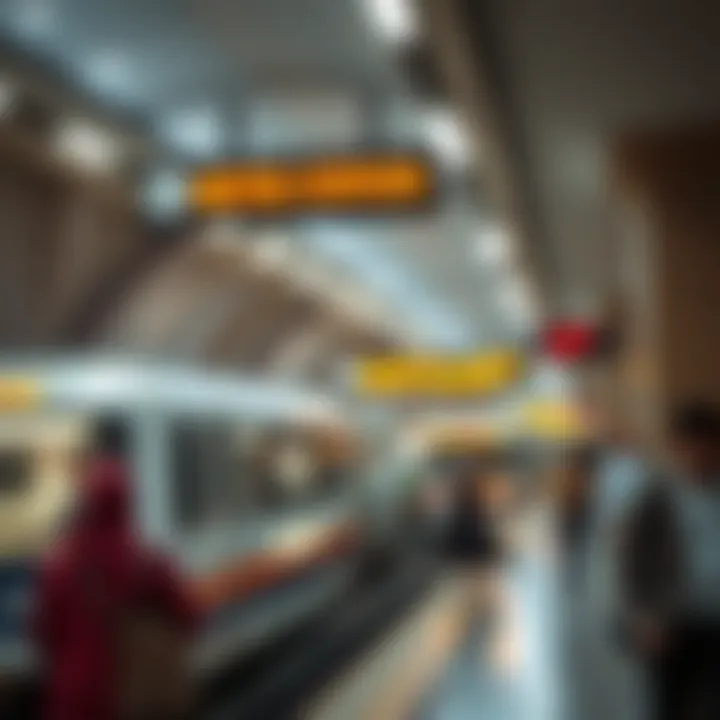
Environmental Considerations and Sustainability
In recent years, there has been a heightened global awareness of environmental issues, and Dubai is no different. The metro system within the city serves as a focal point for discussions on sustainable urban development, showcasing how modern infrastructure can contribute not only to economic growth but also to environmental stewardship. The integration of eco-friendly practices in metro operations plays a vital role in ensuring that the rapid urbanization of the city does not come at a cost to the natural environment.
Eco-Friendly Initiatives
The Dubai Metro is a representative model of sustainability in urban transport. From its inception, several eco-friendly initiatives have been thoughtfully implemented.
- Energy Efficiency: One of the standout features is the use of energy-efficient trains. They incorporate regenerative braking systems that return energy to the grid, reducing overall consumption. This is a smart move, cutting down on power usage during operation.
- Solar Energy: The metro stations and surrounding areas often harness solar panels to generate electricity. This shift towards renewable energy supports the city’s commitment to reducing its carbon footprint and promotes a greener outlook.
- Water Conservation: Efforts are in place to minimize water wastage in metro facilities. Greywater systems, for example, are used to recycle water for landscaping and other non-potable uses.
These initiatives position the Dubai Metro as a leader in sustainable transport, demonstrating a commitment to environmental responsibility that can serve as a model for other cities.
Impacts on Urban Air Quality
Another significant aspect of the metro's influence is its impact on urban air quality. With many residents relying on the metro instead of private vehicles, there has been a noticeable drop in vehicular emissions.
- Reduced Traffic Congestion: By providing a reliable alternative to driving, the metro reduces the number of vehicles on the road. This decrease leads to lower levels of air pollutants like carbon monoxide and nitrogen dioxide. As a result, the air quality in bustling areas has improved, benefiting residents and visitors alike.
"A well-planned metro system not only moves people but also cleans the air they breathe."
- Healthier Environment: Improved air quality translates into a healthier living environment. Studies have shown that increased public transportation use is correlated with lower rates of respiratory issues and other health problems associated with air pollution.
In a city like Dubai, where rapid development often brings challenges to environmental quality, the metro system stands as a crucial element in the push for a cleaner, healthier urban setting. As we look to the future, understanding and enhancing these environmental aspects will be key for ongoing urban development and real estate opportunities.
Future Trends and Developments
Diving into the future of metro lines in Dubai brings us face to face with a landscape ripe for transformation. As urbanization accelerates, the metro system is set to play a pivotal role in shaping both the physical and economic contours of the city. Understanding these future trends is critical for stakeholders in the real estate sector, as they directly influence property values, market dynamics, and investment opportunities. There's a promising trajectory ahead, where advancements in technology and strategic expansions will elevate the efficiency and effectiveness of the metro network.
Technological Innovations in Metro Systems
With technology evolving at breakneck speed, Dubai’s metro system is not one to lag behind. The ongoing integration of smart technologies stands out as a cornerstone of future innovations. Smart sensors, for instance, are helping to optimize train schedules, ensuring that the frequency aligns with passenger flow. This meticulous attention to operational efficiency means less waiting time at stations, which can significantly enhance user satisfaction.
Moreover, mobile applications that provide real-time updates on train timings and occupancy levels are on the rise. Such convenience not only improves the commuter experience but also encourages more residents to opt for public transit over personal vehicles.
- More sophisticated ticketing systems are being introduced, facilitating contactless payments and streamlining the boarding process.
- The use of artificial intelligence for predictive maintenance aims to reduce downtime, thereby keeping trains operational and minimizing delays.
These innovations make the metro more attractive to both residents and businesses, potentially leading to higher property values around stations. As more people rely on this mode of transport, demand for nearby housing and commercial real estate can be anticipated to grow.
Predicted Growth and Expansion of the Network
Looking ahead, the Dubai metro network isn’t just about maintaining its current effectiveness; it’s about expansion. Plans are in motion to extend existing lines and possibly introduce new ones altogether. The anticipated addition of new routes is projected to connect under-served areas, providing greater access to the urban core while promoting equitable growth in suburban regions.
- Extensions of the Red Line and the Green Line have already been announced, aiming to cover key business districts and residential areas. These additions are expected to substantially influence property markets in newly connected neighborhoods, potentially leading to substantial increases in property demand.
- The introduction of more stations will create hubs of activity, culminating in vibrant mixed-use developments that combine residential, commercial, and recreational spaces.
Significantly, as the metro network grows, planners are closely considering sustainable construction methods, ensuring that environmental impact is kept in check. This will not only be beneficial for the ecosystem but also aligns with global trends leaning towards sustainability and green living, making Dubai's metro an attractive option for environmentally conscious investors.
As urban planners look further down the road, the vision entails not just connectivity but a holistic approach to urban mobility. The goal is to create a seamless travel experience that intertwines metro with other transportation modes, shaping a burgeoning metropolis that thrives on accessibility and convenience.
The future of Dubai’s metro lines is not just about transportation; it’s about weaving together a broader fabric of urban life that impacts real estate, commerce, and the everyday experiences of its citizens.
End: The Metro as a Catalyst for Growth
As we draw our exploration of Dubai's metro lines to a close, we see that the system operates far beyond just a means of transportation; it serves as a vital engine driving urban development and economic vitality. Public transit, in general, lays the groundwork for cities to evolve and flourish, and in Dubai, the metro's influence cannot be overstated.
Summarizing Key Insights
The metro lines, particularly the Red Line and Green Line, have reshaped not only the skyline but also the social fabric of the city. By linking key locations, ranging from bustling commercial centers to serene residential enclaves, these lines have created a more integrated urban environment.
- Improved Mobility: The convenience of the metro has streamlined commuting, allowing residents and visitors to navigate the city effortlessly. This ease of access fosters a sense of community and makes Dubai increasingly appealing to expatriates and tourists alike.
- Real Estate Growth: Areas surrounding metro stations have observed a noticeable surge in property values. Investors are keenly aware that homes near these transport hubs often sell faster and at a premium, thus propelling a ripple effect across the real estate market.
"A well-connected city doesn’t just move people; it moves economies forward."
- Environmental Impact: The metro's energy-efficient operation has contributed to a reduction in carbon emissions. As sustainability becomes a priority, this aspect of the metro aligns well with global conservation goals, offering a cleaner mode of transit for residents.
- Social Changes: The introduction of metro lines has led to changes in demographic patterns, encouraging a more diverse population to establish roots in Dubai. The accessibility provided by the metro means that people from various walks of life can cohabit in urban areas previously deemed impractical.
Looking Ahead: The Future of Urban Mobility in Dubai
Looking down the line—quite literally—Dubai’s metro system is poised for expansion and innovation. Proposals for future lines are already in the works, which will further enhance connectivity. As the demands of urban mobility evolve, so too must the infrastructure.
- Adoption of Technology: Expect to see advancements like smart ticketing systems, enhanced safety protocols, and even potential integrations with autonomous vehicles. High-tech solutions could lead to a seamless transport experience, connecting metro rides with other forms of travel with ease.
- Increased Accessibility: Future projects aim to bridge gaps in current coverage, reaching underserved areas while maintaining efficiency for crowded lines. This expansion relates directly to Dubai’s overarching goals of inclusion and comprehensive service.
- Sustainability Goals: The city plans to leverage renewable energy sources for its expanding transit network. This commitment will not only cut operational costs but also reinforce Dubai’s image as a forward-thinking metropolis.
In closing, the metro lines are much more than mere concrete and steel; they are lifelines. As they grow and adapt, they hold the potential to mold Dubai into a more connected, sustainable, and equitable urban landscape. Investors, homebuyers, and developers alike would do well to keep their eyes firmly on the tracks ahead as this dynamic city continues to evolve.












